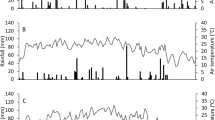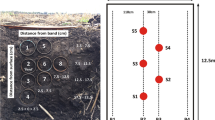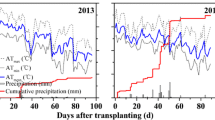Abstract
The rational nitrogen (N) application rate for crops depends not only on yield but also on the environmental cost of N loss to the surrounding ecological environment. To explore the environmental and economic optimal N rate (EEONR) for dryland maize in the hilly areas of southern China, a field experiment was conducted with spring maize from 2015 to 2017. Common urea (CU, control, 240 kg N ha−1) and four polymer-coated urea (PCU) fertilization levels (100PCU, 90PCU, 80PCU, 70PCU, which respectively denotes 0, 10%, 20% and 30% reduction of PCU–N application based on the control) were employed in this trial. Maize yield, N loss and economic return were investigated over 3 years. The results were as follows: (1) relative to CU, a 0–20% reduction in the PCU-N application rate did not significantly affect the maize yield during the three consecutive years, however, a 30% reduction in the PCU-N application rate led to significant yield loss in the third year despite the consistent yields achieved in the first 2 years. (2) PCU application significantly abated N loss to the environment, and as N application rate decreased, N loss significantly reduced. Our results showed that a 0–30% reduction in the PCU-N application rate mitigated N loss by 12.8–46.1% via N2O, NH3, runoff and leaching, and the two main N-loss pathways were leaching (55.2–62.2%) and NH3 volatilization (29.8–36.0%). (3) A 0–30% reduction in the PCU-N application rate resulted in a deficit, ranging from 784 to 2438 CNY ha−1 for increased earnings over CU because of the high purchase price of PCU. The net economic benefit was calculated from the N input cost, yield economic income and environment cost of N lost in the treatments with 0, 10%, 20% and 30% reduction of PCU-N and were − 1820 to 14,479, 402 to 14,612, 2306 to 14,613, and 3941 to 14,205 CNY ha−1, respectively, and the net economic benefit of the CU plot was − 4003 to 14,671 CNY ha−1. In summary, our findings suggest that reducing the PCU-N application rate by 20% is a reasonable EEONR for spring maize cultivation in hilly areas of southern China.






Similar content being viewed by others
References
Akiyama H, Yan X, Yagi K (2010) Evaluation of effectiveness of enhanced-efficiency fertilizers as mitigation options for N2O and NO emissions from agricultural soils: meta-analysis. Glob Change Biol 16(6):1837–1846
Archer DW, Halvorson AD (2010) Greenhouse gas mitigation economics for irrigated cropping systems in north-eastern Colorado. Soil Sci Soc Am J 74(2):446–452
Bouwman AF, Lee DS, Asman WAH, Dentener FJ, Van DHKW, Olivier JGJ (1997) A global high-resolution emission inventory for ammonia. Global Biogeochem Cycles 11(4):561–587
Bremner JM (1995) Recent research on problems in the use of urea as a nitrogen fertilizer. Fertil Res 42:321–329
Bremner JM, Krogmeier MJ (1988) Elimination of the adverse effect of urea fertilizer on seed germination, seedling growth and early plant growth in soil. Proc Natl Acad Sci 85:4601–4604
Bremner JM, Krogmeier MJ (1989) Evidence that the adverse effect of urea fertilizer on seed germination in soil is due to ammonia formed through hydrolysis of urea by soil urease. Proc Natl Acad Sci 86:8185–8188
Brentrup F, Pallière C (2010) Nitrogen use efficiency as an agro-environmental indicator. In: OECD workshop on Agri-environmental indicators
Brodt S, Kendall A, Mohammadi Y, Arslan A, Yuan J, Lee IS, Linquist B (2014) Life cycle greenhouse gas emissions in California rice production. Field Crops Res 169(169):89–98
David N, Ju XT (2015) Environmental costs of China’s food security. Agr Ecosyst Environ 209:5–14
Ehrlich PR, Harte J (2015) Opinion: to feed the world in 2050 will require a global revolution. Proc Natl Acad Sci 112(48):14743–14744
Geng J, Ma Q, Zhang M, Li C, Liu Z, Lyu X, Zheng W (2015) Synchronized relationships between nitrogen release of controlled release nitrogen fertilizers and nitrogen requirements of cotton. Field Crops Res 184:9–16
Geng J, Chen J, Sun Y, Zheng W, Tian X, Yang Y, Li C, Zhang M (2016) Controlled release urea improved nitrogen use efficiency and yield of wheat and maize. Agron J 108(4):1666–1673
Glibert PM, Harrison J, Heil C, Seitzinger S (2006) Escalating worldwide use of urea—a global change contributing to coastal eutrophication. Biogeochemistry 77:441–463
Godfry HCJ, Beddington JR, Crute IR, Haddad L, Lawrence D, Muir JF, Pretty J, Robinson S, Thomas SM, Toulmin C (2010) Food security: the challenge of feeding 9 billion people. Science 327:812–818
Good AG, Beatty PH (2011) Fertilizing nature: a tragedy of excess in the commons. PLoS Biol 9(8):e1001124
Gu B, Ge Y, Chang SX, Luo W, Chang J (2013) Nitrate in groundwater of China: sources and driving forces. Glob Environ Change 233:1112–1121
Hou H, Zhou S, Hosomi M, Toyota K, Yosimura K, Mutou Y, Nisimura T, Takayanagi M, Motobayashi T (2007) Ammonia emissions from anaerobically digested slurry and chemical fertilizer applied to flooded forage rice. Water Air Soil Pollut 183(1):37–48
IPCC (2007) Climate change 2007: The Physical Science Basis. Cambrige University Press, Cambrige, United Kingdom and New York, NY, USA
Ji Y, Liu G, Ma J, Xu H, Yagi K (2012) Effect of controlled-release fertilizer on nitrous oxide emission from a winter wheat field. Nutr Cycl Agroecosyst 94(1):111–122
Kawakami EM, Oosterhuis DM, Snider JL (2013) Nitrogen assimilation and growth of cotton seedlings under NaCl salinity and in response to urea application with NBPT and DCD. J Agron Crop Sci 199(2):106–117
Ke J, Xing X, Li G, Ding Y, Dou F, Wang S, Liu ZH, Tang S, Ding CQ, Chen L (2017) Effects of different controlled-release nitrogen fertilisers on ammonia volatilisation, nitrogen use efficiency and yield of blanket-seedling machine-transplanted rice. Field Crops Res 205:147–156
Melillo JM, Steudler PA, Aber JD, Newkirk K, Lux H, Bowles FP, Catricala C, Magill A, Ahrens T, Morrisseau S (2002) Soil warming and carbon-cycle feedbacks to the climate system. Science 298(5601):2173–2176
Ning TY, Shao GQ, Li ZJ, Han HF, Hu HG, Wang Y, Tian SZ, Chi SY (2012) Effects of urea types and irrigation on crop uptake, soil residual, and loss of nitrogen in maize field on the North China Plain. Plant Soil Environ 58:1–8
Snyder CS, Bruulsema TW, Jensen TL, Fixen PE (2009) Review of greenhouse gas emissions from crop production systems and fertilizer management effects. Agr Ecosyst Environ 133(3):247–266
Sutton MA, Howard CM, Erisman JW, Billen G, Bleeker A, Grennfelt P, Van Grinsven H, Grizzetti B (eds) (2011) The European nitrogen assessment: sources, effects and policy perspectives. Cambridge University Press, Cambridge
Tian Z, Wang JJ, Liu S, Zhang ZQ, Sk Dodla, Myers G (2015) Application effects of coated urea and urease and nitrification inhibitors on ammonia and greenhouse gas emissions from a subtropical cotton field of the Mississippi delta region. Sci Total Environ 533(2015):329–338
Wang SQ, Zhao X, Xing GX, Yang YC, Zhang M, Chen HK (2015) Improving grain yield and reducing N loss using polymer-coated urea in southeast China. Agron Sustain Dev 35(3):1103–1115
Wu W, Ma BL (2015) Integrated nutrient management (INM) for sustaining crop productivity and reducing environmental impact: a review. Sci Total Environ 512–513:415–427
Xia LL, Wang SW, Yan XY (2014) Effects of long-term straw incorporation on the net global warming potential and the net economic benefit in a rice–wheat cropping system in China. Agr Ecosyst Environ 197:118–127
Xie Y, Rong XM, Zhang YP, He X, Shi DJ, Liu Q (2016) Effects of reduced CRNF application on N2O emissions and ammonia volatilization in spring maize soil. J Agro-Environ Sci 35(3):596–603 (in Chinese)
Xie Y, Rong XM, He X, Shi DJ, Tang L, Liu Q, Zhang YP (2017) Effects of CRNF application on nitrogen dynamics and loss of leachate water in spring maize soil in hilly area of South China. J Soil Water Conserv 31(4):180–187 (in Chinese)
Yang YC, Zhang M, Zheng L, Cheng DD, Liu M, Geng YQ (2011) Controlled release urea improved nitrogen use efficiency, yield and quality of wheat. Agron J 103:479–485
Yang YC, Zhang M, Li YC, Fan XH, Geng YQ (2012) Controlled release urea improved nitrogen use efficiency, activities of leaf enzymes, and rice yield. Soil Sci Soc Am J 76:2307–2317
Yang YC, Zhang M, Zheng L, Cheng DD, Liu M, Geng YQ (2013) Controlled release urea for rice production and its environmental implications. J Plant Nutr 36:781–794
Zhao X, Zhou Y, Wang SQ, Xing GX, Shi WM, Xu RK, Zhou ZL (2012) Nitrogen balance in a highly fertilized rice-wheat double-cropping system in southern China. Soil Sci Soc Am J 76:1068–1078
Zheng W, Zhang M, Liu Z, Zhou H, Lu H, Zhang W, Yang Y, Li C, Chen B (2016) Combining controlled-release urea and normal urea to improve the nitrogen use efficiency and yield under wheat-maize double cropping system. Field Crops Res 197:52–62
Zhou Z, Shen Y, Du C, Zhou J, Qin Y, Wu Y (2017) Economic and soil environmental benefits of using controlled-release bulk blending urea in the north china plain. Land Degrad Dev 28:2370–2379
Acknowledgements
This study was financially supported by the National Research & Development Plan (2018YFD0800500) and Platform Project of Educational Commission of Hunan Province of China (15K056). We gratefully acknowledge the technical assistance provided by the Liuyang Experimental Station of Hunan Agricultural University.
Author information
Authors and Affiliations
Corresponding authors
Additional information
Publisher's Note
Springer Nature remains neutral with regard to jurisdictional claims in published maps and institutional affiliations.
Rights and permissions
About this article
Cite this article
Xie, Y., Tang, L., Yang, L. et al. Polymer-coated urea effects on maize yield and nitrogen losses for hilly land of southern China. Nutr Cycl Agroecosyst 116, 299–312 (2020). https://doi.org/10.1007/s10705-019-10038-9
Received:
Accepted:
Published:
Issue Date:
DOI: https://doi.org/10.1007/s10705-019-10038-9




